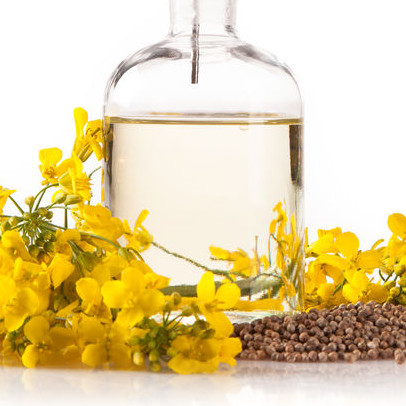
Canola Oil
Also known as rapeseed oil
What is Canola Oil?
Canola oil is one of the most important vegetable oils in food production. It’s currently considered one of the best vegetable oils due to its nutritional value.
In the baking industry, it is used as a moistener and tenderizer in cakes, breads, cookies and muffins. It is also used to make shortening and pastry margarine.1,2 Several types of canola oil have been developed in the last 40 years, such as:
- Low erucic acid oil
- Medium erucic acid oil
- High erucic acid oil
- High oleic oil
Origin
Canola oil is obtained from the Brassica napus and Brassica rapa seeds. This seed was first cultivated 4000 years ago. Industrial production of this oil began in Europe around the 13th century. In 1959, the first low erucic acid canola oil was produced in Canada. Newly-discovered health benefits of canola oil in the 1980’s led to wide expansion in its production and distribution.1
Function
Canola oil serves several purposes in the manufacture of baked goods:3
- Tenderizer: by coating structure building components such as gluten, egg and starch, thus preventing their hydration
- Moistness: by providing the sensation of moistness
- Prevents staling : via retarding starch gelatinization
- Smoothness: by interfering with sugar crystallization and enhancing smooth sensation
- Release agent: aiding in the removal of baked goods from molds
Nutrition
Canola oil is recognized as one of the best vegetable oils due to its health benefits. It provides approximately 120 kcal per tablespoon. Its unique fatty acid profile includes low levels of saturated fatty acids, high levels of monounsaturated fatty acids, and a significant amount of omega-3 and -6 fatty acids. This oil is also a good source of phytosterols and vitamin E.
Consumption of this oil has been associated with lowering blood pressure and gastrointestinal and renal health. It may also help with glucose control in diabetic patients.
Commercial production
Canola oil can be commercially obtained through the following process:1,4
- Cleaning: removal of foreign matter such as dirt and stalks
- Tempering: in cold climates, seeds are heated to 30-40 °C (86- 104 °F) before processing
- Dehulling: removal of hulls using mechanical impact and air separation
- Flaking: seeds are flaked to aid in oil extraction by passing through several rollers
- Mechanical extraction: pressing to form a cake along with 10% removal of oil
- Solvent extraction: cake is extracted with a solvent, typically hexane
- Desolventizing: removal of remaining hexane in the cake
- Distillation: removal of the hexane present in the oil
- Degumming: removal of phospholipids from the crude oil with an acid-oil mixture.
- Refining: further removal of phospholipids with addition of an acid mixture, and removal of free fatty acids with an alkali solution
- Bleaching: removal of pigments and other contaminants with bleaching clay
- Deodorization: removal of undesirable odors
Application
Canola oil can be used in several baking systems such as cakes, cookies, muffins and breads. Its mild flavor helps in preserving the baked good’s own flavors.1,2
Margarines and shortenings made with canola oil are used in various baking applications. It is typically mixed with hard fats such as tallow, palm and fully hydrogenated soybean oil to meet the required specifications.5
FDA regulations
Canola oil is Generally Recognized As Safe (GRAS) by the FDA. In 1985, a low level erucic acid rapeseed oil was recognized as GRAS.5,6
References
- Gunstone, F. Vegetable oils in food technology: composition, properties and uses. 2 nd ed., John Wiley & Sons, 2011.
- McKeon, T, Hayes, D.G, Hildebrand, D and Weselake,R . Industrial oil crops. 1 st ed.,Elsevier, 2016.
- Figoni, P. How Baking Works: Exploring The Fundamentals Of Baking Science. 2nd ed., John Wiley & Sons, Inc., 2008.
- Gunstone, F. D. Rapeseed and canola oil: production, processing, properties and uses.1 st ed., CRC Press, 2004.
- Daun, J.K., Eskin, M and Hickling, D . Canola: chemistry, production, processing, and utilization.1 st ed., AOCS Press, 2011.
- Food and Drug Administration (FDA). US Department of Health and Human Services. CFR Code of Federal Regulations Title 21, Part 184 Direct Food Substances Affirmed as Generally Recognized as Safe, https://www.accessdata.fda.gov/scripts/cdrh/cfdocs/cfCFR/CFRSearch.cfm?fr=184.1555, Accessed 10 July 2020.

